Katakana is the second of the two scripts exclusive to the Japanese language. Like hiragana, katakana consists of a total of 46 basic characters that each represent a basic Japanese syllable. Some of these characters can be modified and/or combined so that the most basic total of syllables in the script is 104. However, there are a number of additional katakana combinations that may appear frequently in your reading material. This is because of the nature of katakana.
Katakana was originally developed—and is still used—for times when the Japanese writer wanted to highlight or call special attention to a Japanese word. This is sort of like the equivalent to ALL CAPS, bolding, underlining, italicizing, or highlighting a word in English. For example, when a Japanese writer wants to write the joyful cry “yatta!” (“all right!”), the writer can write the word in hiragana: やった! However, since someone is probably screaming this joyful cry, the Japanese writer would most likely write the word in katakana: ヤッタ! This makes much more of an impact with the Japanese reader.
Katakana is also the script used to write these loan words in Japanese. Any foreign word—other than Chinese words (as the Japanese kanji alphabet is taken from the Chinese alphabet, Chinese words are naturally written in kanji, even in Japanese)—is most likely written in katakana. This includes a phonetic pronunciation of foreign words for the native Japanese speaker learning a foreign language (just as we use romaji—putting the Japanese word in our own familiar Roman alphabet—to help us learn Japanese words), foreign names and places, and loan words that are similarly pronounced to the original source word but are considered part of the Japanese language, despite originating in a foreign language.
Many of the katakana characters share an angular, simplified resemblance to their hiragana counterparts. Since all hiragana syllables are naturally found in katakana (but not vice-versa), it’s easier to learn hiragana first. Because of these two reasons, make sure you have mastered hiragana before you proceed.
Below is a table of some example words commonly written in katakana:
| English | Romaji | Katakana |
| taxi | takushii | タクシイー |
| Chicago | shikago | シカゴ |
| America | amerika | アメリカ |
| hotel | hoteru | ホテル |
Unless your name is Japanese or Chinese in origin, your name is written in katakana. Unless you were born in Japan or China, your country and city are written in katakana. Katakana takes a little more work to learn than hiragana, but it’s essential to be able to read even basic conversations in Japanese. So let’s get to work! (It’ll be easier and more fun to learn than you think!)
Let’s Learn
Let’s start with the 46 basic katakana characters. Once you learn to read these characters, learning the rest of the syllables will be much easier!
Click on the character to hear it!
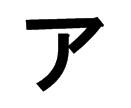 a |
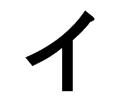 i |
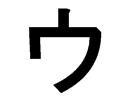 u |
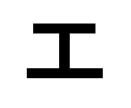 e |
 o |
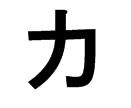 ka |
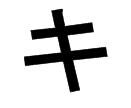 ki |
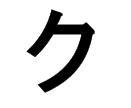 ku |
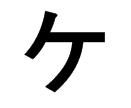 ke |
 ko |
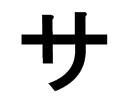 sa |
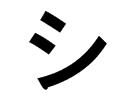 shi |
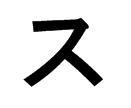 su |
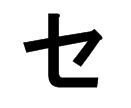 se |
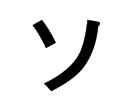 so |
 ta |
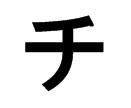 chi |
 tsu |
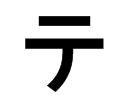 te |
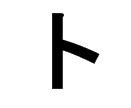 to |
 na |
 ni |
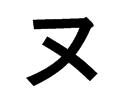 nu |
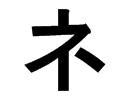 ne |
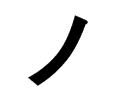 no |
 ma |
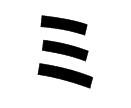 mi |
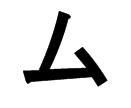 mu |
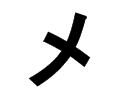 me |
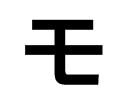 mo |
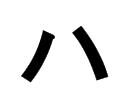 ha |
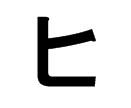 hi |
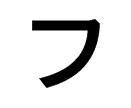 fu |
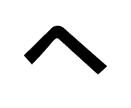 he |
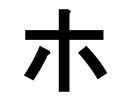 ho |
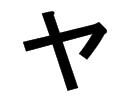 ya |
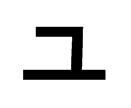 yu |
 yo |
||
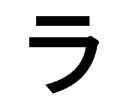 ra |
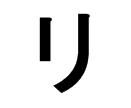 ri |
 ru |
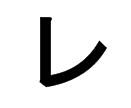 re |
 ro |
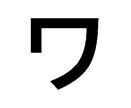 wa |
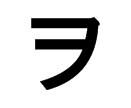 wo |
|||
 n |
||||
Katakana characters are much more angular and simplified than hiragana characters. The only disadvantage of this is that some characters look so much alike, you’ll find yourself confusing them at first! Be careful especially of differentiating “shi” シ and “tsu” ツ (the two dashes are a little more horizontal in “shi” シ than in “tsu” ツ) and “so” ソ and “n” ン (the dash in “so” ソis a little more vertical than in “n” ン).
Like with hiragana, you’ll sometimes see a small “tsu” ッin a word, which you shouldn’t confuse with the large “tsu” ツ. The small “tsu” ッ indicates that the consonant before it should be lengthened, and the proper romanization of a word with a small “tsu” ッ is to double the consonant. In katakana, “kitto” is written キット, not キツト, and “issei” is written イッセイ, not イツセイ.
Katakana has another component that acts similarly to the small “tsu” ッ that doesn’t exist in traditional hiragana. This is the chouonfu, or “dash,” which is used to lengthen consonant sounds in mostly foreign words. (Whereas the small “tsu” ッ is used more often when you’re writing a native Japanese word in katakana to make the word stand out.) The chouonfu has no pronunciation and looks like this: ー. The word “takushii” (“taxi”) has the chouonfu in it: タクシイー. This indicates that the “i” sound at the end should be lengthened when pronouncing the word.
Sometimes you will also see the nakaguro, a dot that looks like this:・. This is an exclusive character in the katakana alphabet with no pronunciation that marks separate words (for the native Japanese speaker, who may not understand where one foreign word ends and another begins). For example, “John Jones” becomes “jon・jonzu” ジョン・ジョンズ. The nakaguro is optional if it’s clear where one word ends and another begins.
Extended
The rest of the most basic syllables in the katakana script are made either by modifying or combining the above 46 characters. Just like with hiragana, to modify a katakana character, you add dakuten (two dots) or a handakuten (circle). To combine a character, you add a small “ya” ヤ, “yu” ユ, or “yo” ヨ to an “i” イ column character.
The basic katakana characters to which you add dakuten to make new sounds are the same as the hiragana character equivalents. And likewise, the handakuten is used only to make “p” sounds (by adding it to the “h” sounds).
The exceptions that don’t follow the simple pattern are “ji” ジ (which is used more often than the “zi” pronunciation), “ji” ヂ (used more often than the “di” pronunciation), and “zu” ヅ (used more often the “du” pronunciation).
The combined characters follow an easy pattern of pronunciation. The only exceptions are “sha” シャ, “shu” シュ, “sho” ショ, “ja” ジャ, “ju” ジュ, and “jo” ジョ.
Usages
As stated above, katakana characters are mostly used for calling attention to native Japanese words, for foreign words, and for loan words considered part of the Japanese vocabulary. For example:
English: Oh no (lit. “It’s terrible!”)! Mary’s glass of milk broke! Romaji: Taihen da! Merii no miruku no garasu wa tsubushimashita! Kana: タイヘンだ!メリーのミルクのガラスはつぶしました!
In this example, “wa” は is the particle that indicates the subject of the sentence. (Remember that when used as a particle, the character that looks like “ha” はis actually pronounced “wa.”) The particle “no” の and the verbs “da” だ (the informal form of “desu” です, the conjugated form of “to be”) and “tsubushimasu” つぶします are in hiragana because they’re native Japanese words that don’t have kanji forms. They’re also not being highlighted here.
“Taihen” is a native Japanese word, usually written in kanji (大変) or hiragana (たいけん). However, since someone is screaming out, “oh no!”, “taihen” is written タイヘン in katakana to highlight or bold the word.
“Mary” is a foreign name, so it’s written in katakana: メリー. To write “Mary” in any other Japanese script would be incorrect, although some foreigners may choose to do so for artistic reasons.
“Miruku” ミルク and “garasu” ガラス are foreign loan words (originally from the English “milk” and “glass”) that are considered part of the Japanese language. However, to indicate their foreign roots, they’re written in katakana. There are very few exceptions to this rule. However, “coffee” is one of them. It can be written either in katakana: “koohii” コーヒー or in kanji “kouhii”: 珈琲.
Conclusion
Once you know katakana (after mastering hiragana), you’ll be able to comfortably read basic Japanese texts, even if you don’t understand them. What does “read and not understand” mean? For example, even if you don’t know what this English word means—“zeugma”—because you know how to read English Roman character script, you can at least guess how to pronounce the word. Japanese is even easier than in English in that respect; you’ll know how to pronounce a word, not just be able to guess!
Don’t be overwhelmed by all of the special rules (many not even mentioned here!) for putting foreign words into katakana. If you have a thorough understanding of the 104 basic combinations and the eight special rules discussed here, you’ll be able to navigate through new katakana rules you come across with relative ease.
Like with hiragana, the only way to learn katakana is through rote memorization. So get to it! This website offers flashcards and quizzes to help you this necessary process.
